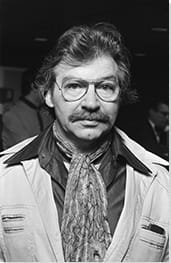Summary of Karel Appel
Karel Appel was a major painter of the post-war era in the Netherlands, as renowned for his colorful personality as for his free-flowing, spontaneous approach to his work. As a founding member of the CoBrA group, along with his Dutch compatriots Corneille Guillaume Beverloo and Constant Nieuwenhuys, Appel developed a radically new approach to painting. He believed in a wholly unschooled form of creative expression, and looked to the art produced by children, mental patients, and artists working outside the canon (Folk artists) for inspiration. Appel created a vibrant and diverse body of work to rival that of Jean Dubuffet for its striking singularity of manner.
Accomplishments
- Appel and the artists of CoBrA were pioneers in that their art rejected not only the history of figurative painting but also the strictures of avant-garde art. Working in the wake of World War Two in a Europe that was rebuilding itself in new ways, the CoBrA group saw the old experimental factions such as Surrealism and De Stijl, regrouping under the same banners, with the same stiff rules. The group tried to unburden themselves from any of the typical styles of art history, including those that had previously been seen as radical, painting with total freedom and lawlessness.
- The figure of the child was a particularly important one for Appel. Whereas the best-known exponent of untutored art, Jean Dubuffet, often turned to artists diagnosed with mental illness for his wellspring of untutored creativity, Appel looked back to youth. His paintings and murals often depict children, and are created with the same automatic and simplistic gestures, crude outlines, and anatomical anomalies we associate with children's art.
- Appel was unusual amongst his northern European peers for the time he spent in the USA in the 1950s. While there he connected with many Abstract Expressionist artists and his work began to bear its influence, particularly that of his friend Willem de Kooning. In this respect, Appel's work represents an interesting point of convergence between European and North-American trends in mid-twentieth-century art.
Important Art by Karel Appel
Questioning Children
Questioning Children is an example of Appel's use of found and discarded items as art materials, which he used to create a series of relief paintings he called his Objets Poubelles (trash objects). In its imagery of "questioning children" who may in fact be asking for food or money, the work also shows Appel's engagement with the destructive impact of World War Two. This work is typical of the CoBrA movement's break away from De Stijl-style minimalism and the hyper-naturalism of Surrealism, with its expressionistic, figurative approach and conscious brashness and crudeness of form
Constructing his painting surface from pieces of discarded wood and a found window-shutter, Appel imbues a playful image with subtle formal allusions to the havoc wreaked by war. Indeed, this reference is mirrored at a thematic level. Though the image is in part a joyful and colorful one, its original Dutch title, Vragende Kinderen, translates not as "questioning children" but as "begging children." This reference confronts the viewer with the destitution and poverty that were widespread across the Netherlands and Northern Europe after 1945, as shattered infrastructure and economies were rebuilt. If we look closely at the faces of these children, we might feel that they are not gleeful or energetic but manic and grief-stricken.
Appel used the same title for a controversial mural created for the cafeteria of Amsterdam's city hall. Both paintings were completed in 1949 but the mural version, which also addressed the theme of war, was publicly criticized, with city officials pressured into covering it over with newspaper. As well as being scandalized by Appel's childlike painting style, many members of the public wanted to move on from the mental scars of the recent conflict, and did not appreciate Appel's confronting imagery, informed by the Marxist ideas of the CoBrA group.
Gouache on wood - Collection of the Tate, United Kingdom
Hip, Hip, Hoorah!
In contrast to the seriousness of Questioning Children, Appel's Hip, Hip, Hoorah! offers a lighthearted and optimistic vision of the world, informed by the imagination of youth. The piece speaks to the feeling of artistic liberation that Appel and the CoBrA group had achieved by drawing on unconventional sources such as children's art for inspiration. While we might draw a thread of influence to artists such as Paul Klee, this work is radically unlike the formal abstraction of, say, Cubism. Rather than breaking up the picture plane as an academic exercise, the CoBrA artists began by trying to rediscover the quick, clumsy pictorialism of children or untutored artists.
Against a dark background, a gaggle of colorful and stylized figures boldly state their presence. These strange, human-animal hybrids are influenced by children's painting, often created by artists who have not yet internalized the physical distinctions between different kinds of figurative forms. Legs, arms, and heads are combined from different sources, human and non-human, with wild abandon, growing from unexpected points on the bodies. Appel referred to his evocative, semi-anthropomorphic beings as "people of the night," which explains the stark black setting.
The bold color contrast, combined with Appel's gestural application of paint, contributes to an illusion of motion. Each figure has the feeling of being in flux. The human-bird hybrids appear as if they are in flight, while each character's large eyes create a feeling of bewilderment and excitement.
Oil on canvas - Collection of the Tate, United Kingdom
Amorous Dance (Danse Amoureuse)
Around 1954, Appel's early style, reminiscent of children's art, gave way to a different mode of painting. The new approach was more invested in the material qualities of paint itself: the way it could be applied to suggest different emotions and psychic states. This composition is also notable for a more exaggerated form of abstraction. Whereas in many of Appel's paintings we can easily make out the childlike outlines of limbs, bodies, or faces, here the contours of the two dancers are difficult to observe, with the figures practically blended into the background.
Danse Amoureuse indicates the connection between Appel's style and Abstract Expressionism. During his time in North America in the mid-to-late 1950s, Appel befriended the Dutch painter Willem de Kooning. Through de Kooning and other key members of the New York School such as Franz Kline, Appel became aware of the emphasis these artists placed on the physical act of painting. He came to describe the moment of painting in very visceral, bodily terms: "I slap at the paint with brushes and palette knives and my bare hands."
It may be that this piece represents something of Appel's frustration with the collapse of the CoBrA group, and his search for alternative sources of inspiration during his stint in the US. Certainly, Danse Amoureuse has an almost aggressive quality of energy and motion to it, achieved through Appel's bold and exuberant brushwork. Its color palette is also more muted, more suggestive of the legacies of Analytical Cubism, that the brash, poster-paint tones of some of Appel's work.
Oil on canvas - Collection of the Tate, United Kingdom
Mindscape No. 12
Appel's Mindscape series includes some of his most purely abstract painting. It also indicates his long-term engagement with the principles of "Art Informel" that prevailed in France during the 1940s-50s. Art Informel was a term which brought together a number of recent artistic movements and trends France and Northern Europe, including Art Brut, Tachisme, lyrical abstraction, matter painting, and the New York school.
Appel's Mindscape No. 12 is painted in the Tachiste style, often considered the European response to North-American Abstract Expressionist painting. Tachisme is generally defined by dynamic and spontaneous mark-making, including gestural brushwork, drip painting, and pouring paint from the tube onto the canvas. Although this mode of painting fell out of favor as postmodern movements such as Pop Art and Minimalism superseded Expressionism in the 1960s, Appel continued to apply Tachiste technique in his late paintings, often by applying paint directly from the tube and thickening it with mediums such as sand. Appel called the physicality and material qualities of paint "de materie" (the matter). Mindscape No. 12 exemplifies Appel's formal interest in the textural possibilities of paint.
The variety of textures in the composition emphasizes the color contrasts, and suggests a topographical survey of the subconscious mind. The profile of a person's head can be loosely seen but there are no realistic or defining facial features. Mindscape No. 12 is thus a speculative mapping of the psyche rather than an anatomical representation. The painting is part of a group of 13 works started in 1976 called the Visage-Paysage (Face Landscape) series. The series was an attempt to depict a fusion between human physiognomy and landscape-esque scenes.
Oil on canvas - Private Collection
Nude No. 27
Although Appel is known for his childlike imagery, more closely aligned with Art Brut than academic art, he also created Expressionist-style nudes that are perhaps easier to connect to the canon of Western art history. Curator Franz Kaiser states: "this is probably the most classical theme you can think of, the thing that's most identified with academicism...You wouldn't expect Karel Appel to do that, but he did it all the time."
Appel's late series of nudes indicates the fluctuations within his style and the breadth of his artistic influences. His nudes have an affinity to Willem de Kooning's iconic nudes from the 1950s, and blur the boundary between figuration and abstraction in a similar way. The works are created using spontaneous and gestural application of paint, in thick layers, without preconceived sketches or underpainting. Although Appel employed live models as the basis for these paintings, his nudes represent more of an archetypal and symbolic sense of the human body than an anatomical one. Appel's automatic process of painting results in a composition where the figure and background are nearly indistinguishable. These paintings adhere to his overarching belief in a non-didactic painterly style that is informed by playful explorations and subconscious discoveries.
Appel's nudes feature both male and female bodies. Unlike many common depictions of nudes throughout the history of art, they are not idyllic, romantic, or languid. Appel's nudes are the antithesis of static. As art historian and curator Rudi Fuchs notes: "the upright nude can move at any moment and change position. This movement could be abrupt, slow, dramatic, violent, aggressive; the painter can derive and develop a number of different expressions from this figure." Fuchs connects this quality of motion to the artist's creative technique: "this mobility, lifelikeness, can be seen as a logical translation in the way the nudes are painted: with passionate, powerful strokes in bright colors. The painter's movements are compressed on the narrow surface, making them appear all the more intense."
Oil on canvas - Private Collection
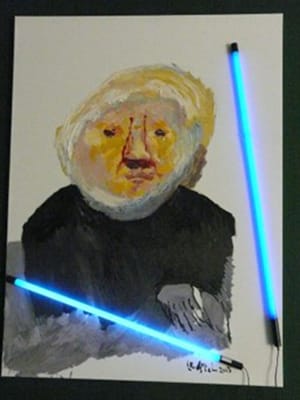
Portrait of Rudi Fuchs
This late portrait by Appel pays homage to Rudi Fuchs, a Dutch curator, art historian, and museum director who exhibited and contextualized Appel's work. The pair first met in 1986 when Fuchs was director of the Van Abbemuseum Eindhoven in Eindhoven, Netherlands and the Castello di Rivoli in Turin, Italy. They kept in touch until Appel's death.
Appel's portrait offers a simplified likeness of Fuchs's face, painted in a gestural and impasto manner. The inclusion of two blue tubes of neon light is indicative of Appel's late work, which sometimes involving exploration with neon tubes affixed to canvas. The neon light acts as a spotlight, framing and emboldening Fuchs's face.
Appel and Fuchs agreed that this painting should be donated to a museum and chose the Van Abbemuseum where Fuchs served as director from 1975 through 1987. The museum holds a collection of significant works of art made by artists from the CoBrA group.
Oil and neon lights on canvas - Collection of the Van Abbenmuseum, Eindhoven
Biography of Karel Appel
Childhood and Adolescence
Christiaan Karel Appel was one of four children born in Amsterdam, the Netherlands, to parents Jan and Johanna (née Chevalier) Appel. His father owned a barbershop that was located on the ground floor of the family's house. His mother was a descendent of the French Huguenots.
Early Training and Work
Appel started to show serious artistic interests at around fourteen. His first known painting from this time is a still life of a basket of fruit. For his fifteenth birthday his uncle, Karel Chevalier, who was an art aficionado and amateur painter, bought Karel a paint set and gave him some lessons. Appel furthered his early artistic training by taking lessons from his uncle's teacher, Jozef Verheijen, although his immediate family was not wholly supportive of his decision to pursue art. The Karel Appel Foundation refers to the importance of romantic literature such as Walt Whitman's "Leaves of Grass" (1855) to the young artist.
The artist's formal training took place between 1942 and 1944 at the Rijksakademie van Beeldende Kunsten in Amsterdam. At art school Appel met and befriended Corneille Guillaume Beverloo (better known as Corneille) and Constant Nieuwenhuys (better known as Constant). His studies coincided with the German occupation of the Netherlands so he faced significant obstacles in his path to becoming an artist - though his admission into the art academy protected him from forced labor in one of the Nazis' local munitions factories. In 1944, Appel was placed under police surveillance because they suspected him of sheltering individuals trying to evade forced labor. Nevertheless, Appel held his first solo exhibition of painting in 1946 at Het Beerenhuis in the Dutch city of Groningen.
In July of 1947, Appel, Constant and Corneille started the avant-garde art collective Experimentele Groep Holland (Experimental Group Holland). In September, the group started publishing its own magazine, Reflex. The inaugural issue contained a Marxist-inspired manifesto by Constant calling for avant-garde art that would disrupt traditional modernist conventions, making art more obtainable for mainstream audiences and more relevant to everyday experience. Through Constant's introduction, Appel and Corneille met Christian Dotremont in Brussels. Dotremont was a founder of Surréalisme Révolutionaire (Revolutionary Surrealism), a post-World-War-Two group that sought to connect the Surrealist movement with revolutionary political themes and activities.
It is worth noting the dominance of the De Stijl movement and the reverence in which its founder, Piet Mondrian, was held in the Netherlands at this time. Appel set out his stall early against the traditions of Constructivism and reductionism that this movement represented, which he felt was dominated by rules, erased intuition and emotion, and prevented social engagement. Experimentele Groep Holland can be conceived partly as a pushback against the post-De Stijl model of Dutch art. Indeed, in many ways, Appel's later embrace of the figure of the child represented a conscious affront to the overly-learned approach to art embodied, in Appel's eyes, by Dutch modernism.
Mature Period
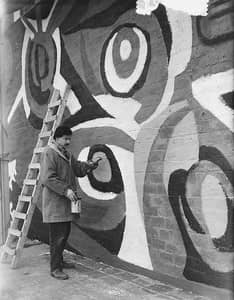
Appel's career breakthrough came in the fall of 1948, when he became a founding member of CoBrA movement. On November 8, Appel, Constant, Corneille, and Dotremont participated in an international conference on avant-garde art in Paris, organized by the French and Belgian chapters of the Revolutionary Surrealists. Disagreeing with the ideology and direction of the French chapter they decided to leave the meeting, and were joined by fellow artists Asger Jorn and Joseph Noiret at the Café Le Notre Dame. During this gathering the group chose to form a new collective without settling on an official name. The term "CoBrA" was coined later by Dotremont, during the penning of the group's written declaration "Cause était Entendue" (The Case is Closed), by combining the first letters of Copenhagen, Brussels, and Amsterdam, the cities that the various members came from.
CoBrA extended the Experimental Group Holland's ideas around creating more accessible and socially conscious forms of avant-garde art. The group was also formed in response to what the artists considered the rigid and pedantic aspects of European modernist and avant-garde movements such as Surrealism. They considered the formalization and academic conceptualization of the avant-garde antithetical to its spirit. CoBrA responded by turning to untutored artistic styles for inspiration, including the art made by young children and the work of untrained adult artists, or "folk artists." In this sense, their activities were similar to those of Jean Dubuffet and the Art Brut movement. The figurative motifs and patterns Appel used in his art were often meant to resemble the different visual approaches that children moved through during their early creative development.
Appel's mature paintings combine abstract and representative elements, with gestural brushwork and an impasto technique using thick, heavy layers of paint. He worked with a stock of oil paint that he had found when an old paint shop closed down, and which he stated had been there since the seventeenth century. In an interview published in Elsevier in 1990, Appel noted: "I'm able to paint so nice and thick with those big splodges that stay upright because I mix my own paint. I use the formula that the seventeenth-century painters used and I've added one or two things myself. A very important element is stand oil. I once got hold of a whole barrel full [from the seventeenth century] and I'm still using it. There are pots of it in all my studios, in New York, in Connecticut, in Monaco, and in Tuscany....I mix my oil paint with it, and I throw in a lot of eggs and some concentrated turpentine. It's as thick as homemade mayonnaise. When it dries it is as tough and hard as rubber."
Another important element within Appel's oeuvre is his use of what he called Objets Poubelles or "trash objects." Appel incorporated everyday items and unconventional materials like scrap wood and window shutters into his paintings, giving them something of the quality of three-dimensional constructions or assemblage. Appel was also a prolific sculptor, creating fantastical and playful figures that also incorporated salvaged objects and reflected his interest in childlike subject-matter. He became famous for his public commissions, including painted murals, large-scale site-specific objects, and stained-glass designs.
Just as Appel was beginning to enjoy artworld acclaim he became embroiled in a controversy regarding a large mural which he had created for the cafeteria of Amsterdam City Hall in 1949. The wall-painting, titled Questioning Children, was considered too obscure for the Dutch public, who protested against its display, leading city officials to cover it with wallpaper. Angry at his treatment, the artist relocated to Paris, while the mural was defended by artistic peers such as influential Dutch architect Aldo van Eyck.
In Paris, Appel became inspired by the art made by patients in mental-health asylums. In 1950, he saw an exhibition of works by residents at Saint-Anne Hospital. Returning frequently, he created one of his most formative works, Psychopathological Notebook, in response. This included a series of drawings, collages, and gouache paintings made on top of pages from the exhibition brochure, which included descriptions of the patients' "pathologies." Appel's art was lauded by influential figures in the French art scene, including art critic Michel Tapié. Appel was one of the key artists Tapié featured in his 1952 book Un Art Autre (Another Kind of Art). The publication was a major contribution to the art-historical contextualization of French post-war painting, which Tapié considered to be a radical departure from prior academic formalism. He coined the term "art informel" (which later came to define the Art Informel movement), derived from the French word "informe," which means "unformed" or "formless." The book's publication coincided with an exhibition of the same name, curated by Tapié at Studio Paul Facchetti in Paris.
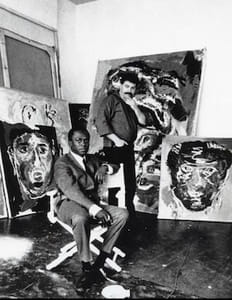
The 1950s were a prolific decade for Appel. In February 1951, Michel Ragon organized CoBrA's inaugural exhibition in Paris at the Librairie 73, Boulevard St. Michel, shortly after which the group disbanded. Although most of the artists remained friendly, the demise of CoBrA put a strain on Appel's relationship with Corneille, whom he had considered his closest friend in the collective. Around the same time, Appel received a commission from Amsterdam City Council to paint a mural for the foyer of the Stedelijk Museum's auditorium. The mural is popularly known as "Appel-Bar." In 1953, Appel was given his first major solo exhibition at the Palais des Beaux Arts in Brussels, while the following year he received the UNESCO Prize at the 1954 Venice Biennale, and in 1956 received a commission to paint a mural for the restaurant of Amsterdam's Stedelijk Museum.
In 1954 Appel held his first exhibition in the United States, after which he spent a period of time living and working in New York City. At the behest of Michel Tapié, he met the gallerist Martha Jackson, whose eponymous New York gallery promoted established and up-and-coming avant-garde artists. During a visit to Appel's studio, Jackson purchased two oil paintings and several gouaches. In 1957 he was offered a solo show at the gallery. Appel would go on to be represented by the Martha Jackson Gallery for nearly two decades. In 1955, Appel's painting Child and Beast II (1951) was selected to be displayed at the Museum of Modern Art (MoMA) in New York as part of a major group exhibition of European modern art titled The New Decade. While in New York City, Appel befriended his Dutch compatriot, the famous Abstract Expressionist painter Willem de Kooning. He also became interested in American Jazz music and painted portraits of Miles Davis and Dizzy Gillespie.
In 1962, Appel's friend, the notable Belgian author Hugo Claus, published the first major monograph dedicated to his art. Throughout the 1960s, Appel's work was displayed in many notable European art venues and he received several commissions to paint murals on public buildings. In the 1970s a traveling retrospective of his work was exhibited across North America.
Later Years and Death
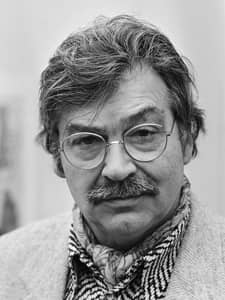
Appel spent much of the 1970s travelling back and forth between Europe and the United States, specifically between his studios in New York and France. During this period, he met Annina Nosei, a gallerist later known for her support of the American Neo-Expressionist painter Jean-Michel Basquiat. In 1973, Appel began a relationship with Hennie Sutopo, with whom he travelled widely, including a 1976 sojourn to Lima, Peru, where Appel painted murals with children from the local town of Villa El Salvador. When the couple returned to Europe, Appel started a collaboration with Pierre Alechinsky, a former-member of CoBrA. Sutopo and Appel separated in 1977 and he began the longest and most substantial relationship of his life, with Harriet de Visser. De Visser helped both to advance his practice and support his legacy by establishing an archive, assuming an administrative and managerial role within his studio. Appel also began to explore landscape painting during the 1970s.
In the 1980s, Appel began a decade-long artistic and literary collaboration with beat poet Allen Ginsberg. Ginsberg reflected on their work together in his essay-memoir "Playing with Appel:" "The day before May Day, Naropa arts faculty's philosopher-historian Jose Arquelles and staff set up a big room of Masonite and art boards and acrylic in the old classroom where I'd taught International Heroic Twentieth Century Poetics the summer before. We'd been preparing a Jack Kerouac Festival, 25th Anniversary of On The Road publication for midsummer and had asked Appel if he would make us a poster image. That became the motif of two paintings. I don't remember the sequence. Karel started the big one with wild colors, "bold strokes", Fauve-Cobra intuitions. But he knew what he was doing - after a while the classic image of J.K. appeared rough and ready, gleaming giant, unfinished. Then Karel handed me the brush, to put on words. Now that's where he opened my mind. I had no idea how to hold the brush, what color, where to lay the words. I could think of a few words but why would he trust me not to make a mess of his enormous colored brush-wet visage? 'Well, just go ahead - any color that you think,' he said."
It is also worth noting the influence that Appel began to assert on younger artists during the 1980s-90s. In 1984, Annina Nosei, who promoted the work of Jean-Michel Basquiat, showed Appel's painting at her gallery in 1984. As art critic Paul Laster notes, it was likely that Basquiat became familiar with Appel's paintings through the influence of Nosei. Laster states that "[t]here's definitely an affinity between the two men's style of painting, particularly in Basquiat's ferocious heads and his childlike figures from his early works."
Appel's other notable collaborations from this period include his work with Japanese dancer and choreographer Min Tanaka and Vietnamese composer Dao for the ballet Can We Dance a Landscape? Appel created a mixed-media landscape of paintings, sculptures, polaroid photographs, and rope. He continued to design sets for operas such as Noach at the Nederlandse Opera in Amsterdam in 1994 and a production of Mozart's Die Zauberflöte (The Magic Flute) at the Nederlandse Opera in 1995.
In spite of his reputation as an artist at odds with academic style, in the 1990s he created a series of nudes, responding to classic motifs and tropes of Western portraiture. However, his approach to the genre was unusual: "I paint the nude not in order to imitate nature, nor to come as close as possible to nature. I use the nude as inspiration for making a painting which is called a nude. For all that freedom that I won after fifty years of painting - freedom and technique, color and design - is then suddenly concentrated in the form of a nude. And every nude gives it yet another vibration, another emotional association, and this leads to a painting which is different in color and form. I look very much for a form which is more or less different. There's not a whole lot you can do with a nude. We all have two arms, two legs, two eyes, a head, so that's what you've got to work with."
The 1990s were a decade of consolidation for Appel. His Psychopathological Notebook was exhibited for the first time, 42 years after its creation, in the 1992 exhibition Parallel Visions: Modern Artists and Outsider Art at the Los Angeles County Museum of Art. In 1997, Swiss artist Johannes Gachnang published the formative series of drawings and gouaches, making it even more visible to a public audience. In the 2000s, Appel's health declined, limiting his extensive travel and art-production schedule. In 2003, he received the prestigious French Légion d'Honneur, in the grade of Officer. He continued experimenting using nontraditional and unique art materials, beginning a series of work with neon tubing in 2005. That same year, Appel underwent heart surgery and rehab in Switzerland.
Appel died on May 3, 2006, in Zurich. In 1999, he had established the Karel Appel Foundation in Amsterdam, which continues to promote his legacy by advancing scholarship on his career and displaying his work throughout the world.
The Legacy of Karel Appel
Since his death, Appel's art has continued to be well regarded, exhibited widely, and prized by collectors. He is often associated with artists of the same era such as the French painter Jean Dubuffet and Danish Asger Jorn who, like Appel, challenged the strictures of modernist and avant-garde movements previously seen as breaking conventions themselves, and painted with a new kind of spontaneous freedom. Appel was also influential for his larger-than-life personality. Curator Klaus Ottmann describes Appel as a trailblazing cultural figure whose "fast rise as an artist was to a large extent due to his unabashed public persona and his direct painting style that provoked public and critical debates."
Appel's advocacy of, and appreciation for, children's art and the work of untrained artists, led to a more serious appreciation and embrace of artwork outside of the traditional canon. In this, his pursuits mirrored those of the Art Brut movement championed by Dubuffet. Art historian Phillip Barcio writes that "[b]y embracing true originality, Appel eliminated the need for adherence to any path other than the free expression. Through his work we learn that the important thing isn't just to collect, categorize and admire the products of an artist's labor, but to marvel at the originality and freedom from which these objects came, and to embrace their source as the truly precious and unending process of creativity."
Influences and Connections

-
![Asger Jorn]() Asger Jorn
Asger Jorn - Corneille Guillaume Beverloo
- Constant Nieuwenhuys
- Joseph Noiret
- Christian Dortremont
-
![Art Brut and Outsider Art]() Art Brut and Outsider Art
Art Brut and Outsider Art -
![Expressionism]() Expressionism
Expressionism -
![Surrealism]() Surrealism
Surrealism -
![Art Informel]() Art Informel
Art Informel - Children's Art
-
![Jean-Michel Basquiat]() Jean-Michel Basquiat
Jean-Michel Basquiat ![Bjarne Melgaard]() Bjarne Melgaard
Bjarne Melgaard
-
![Asger Jorn]() Asger Jorn
Asger Jorn - Corneille Guillaume Beverloo
- Constant Nieuwenhuys
- Joseph Noiret
- Christian Dortremont
-
![Pop Art]() Pop Art
Pop Art - Book Art
- Figurative Expressionism
Useful Resources on Karel Appel
- Karel Appel, PainterBy Hugo Claus
- Karel Appel: Street Art, Ceramics, Sculpture, Wood Reliefs, Tapestries, Murals, Villa El SalvadorBy Pierre Restany
- Karel AppelBy Alfred Frankenstein
- CoBrA: A History of a European Avant-Garde Movement (1948-1951)Edited by Willemijn Stokvis
